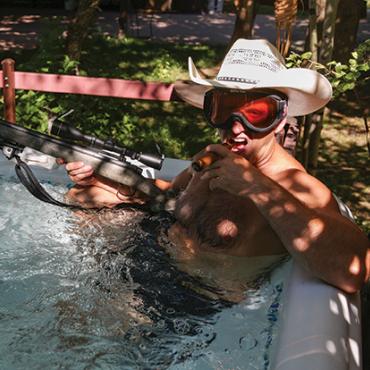Sustaining Montana
When it comes to natural beauty, the Gallatin Valley and surrounding area are pretty hard to beat. Spectacular mountain views; crystal-clear streams and rivers; vast, untrammeled forests; a magnificent assortment of fish and wildlife—all these environmental gifts lend a unique and invaluable aesthetic character to Southwest Montana. And while most of us would like nothing more than to simply revel in it, soaking it in and playing the days away without a care, it’s becoming increasingly difficult to ignore a singularly unfortunate reality: all this incredible beauty is at risk. Reckless, widespread land development, both private and commercial, threatens to despoil the landscape and its incomparable natural splendor.
Careful O/B readers know that we’re not raging environmentalists advocating the dissolution of all industry. Nor do we yearn quixotically for the low-impact era of deerskin-clad cavemen huddled around a campfire. Progress does, after all, have its benefits. But we love Montana and we treasure the outdoors, and if it takes a few sacrifices and lifestyle adjustments to preserve our state’s beauty and our cherished way of life, so be it.
Hence this issue’s attention to sustainability. As Graham Curry states in “Sustainable Living in Montana” (page 62), sustainability refers to “methods of harvesting or using a resource so that the resource is not depleted or permanently damaged, thus protecting it for future generations.” These methods encompass everything from small-scale agriculture to the construction of private homes, both of which we’ve featured in this issue. (Look for more articles about sustainability in upcoming issues.)
But sustainability need not be limited to food and building materials. Beauty is a resource too, as Teddy Roosevelt so astutely noted. And Montana’s immeasurable beauty is what helps form such intense bonds between Montanans and their home state. Diminish that beauty, and we’ll begin to lose our sense of place—and with it, our connection to the land around us. An undeniable part of Montana’s beauty is open land—the very thing that’s most in danger of being lost. So is the diversity of recreation that takes place upon and around that land, from hiking and mountain-biking to fishing and four-wheeling. To all the naysayers out there who think there’s no reason to regulate development, we say this: there’s a reason you don’t see travel posters reading Visit Brooklyn—the Last Best Place!
The point is, sustainability is about much more than reducing your water consumption and buying organic milk. It’s about living and behaving in ways that ensure the natural beauty and recreational opportunities of Montana are preserved—not just for our own purposes, but also for the benefit of future generations. So resist the urge to build your dream cabin on a riverbank. Lecture your friends when they start talking about carving a 20-acre ranchette out of an otherwise wild and open landscape. And, as Dave Schroeder advocates in “Armchair Activist” on page 20, take some time and work to protect the beauty and health of our rivers, mountains, and forests—and in so doing, help ensure that the natural beauty that’s all around us will continue to inspire and sustain Montanans for generations to come.
Careful O/B readers know that we’re not raging environmentalists advocating the dissolution of all industry. Nor do we yearn quixotically for the low-impact era of deerskin-clad cavemen huddled around a campfire. Progress does, after all, have its benefits. But we love Montana and we treasure the outdoors, and if it takes a few sacrifices and lifestyle adjustments to preserve our state’s beauty and our cherished way of life, so be it.
Hence this issue’s attention to sustainability. As Graham Curry states in “Sustainable Living in Montana” (page 62), sustainability refers to “methods of harvesting or using a resource so that the resource is not depleted or permanently damaged, thus protecting it for future generations.” These methods encompass everything from small-scale agriculture to the construction of private homes, both of which we’ve featured in this issue. (Look for more articles about sustainability in upcoming issues.)
But sustainability need not be limited to food and building materials. Beauty is a resource too, as Teddy Roosevelt so astutely noted. And Montana’s immeasurable beauty is what helps form such intense bonds between Montanans and their home state. Diminish that beauty, and we’ll begin to lose our sense of place—and with it, our connection to the land around us. An undeniable part of Montana’s beauty is open land—the very thing that’s most in danger of being lost. So is the diversity of recreation that takes place upon and around that land, from hiking and mountain-biking to fishing and four-wheeling. To all the naysayers out there who think there’s no reason to regulate development, we say this: there’s a reason you don’t see travel posters reading Visit Brooklyn—the Last Best Place!
The point is, sustainability is about much more than reducing your water consumption and buying organic milk. It’s about living and behaving in ways that ensure the natural beauty and recreational opportunities of Montana are preserved—not just for our own purposes, but also for the benefit of future generations. So resist the urge to build your dream cabin on a riverbank. Lecture your friends when they start talking about carving a 20-acre ranchette out of an otherwise wild and open landscape. And, as Dave Schroeder advocates in “Armchair Activist” on page 20, take some time and work to protect the beauty and health of our rivers, mountains, and forests—and in so doing, help ensure that the natural beauty that’s all around us will continue to inspire and sustain Montanans for generations to come.






